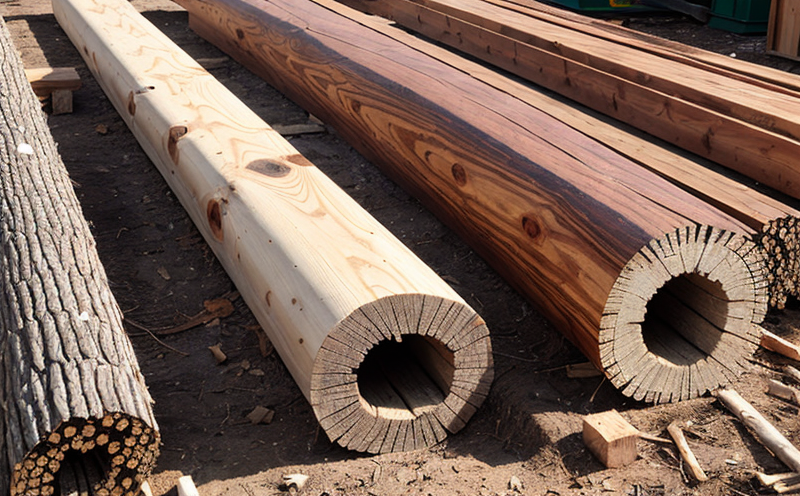Leaching Resistance Testing of Wood Preservatives
The leaching resistance testing of wood preservatives is a critical aspect in ensuring the longevity and durability of wooden structures, especially those used in agricultural and forestry applications. This test evaluates how effectively wood preservation chemicals remain within the treated wood over time under various environmental conditions. The integrity of these treatments directly impacts the performance and sustainability of wood-based products.
The testing process begins with selecting appropriate specimens that represent the intended end-use application. These samples are typically cut to standard dimensions, ensuring they are representative of the wood type and size used in construction projects. The specimens undergo a series of immersion tests where they are exposed to water or specific chemical solutions designed to simulate real-world conditions such as rain exposure.
After immersion, the specimens are dried under controlled conditions to remove excess moisture. This drying step is crucial for obtaining accurate measurements of leachate concentrations because it ensures that any variations in weight change can be attributed solely to the loss or gain of chemicals rather than residual water content. Once dry, the specimens are weighed and analyzed for changes in mass, which indicates how much of the preservative has been released into the surrounding environment.
The results from these tests provide valuable insights into the effectiveness of different wood preservatives on various types of wood species. By comparing the amount of leachate obtained after prescribed exposure periods, researchers and manufacturers can optimize their formulations to achieve better retention rates while maintaining adequate protection levels against insects and fungi.
Standardization is essential for consistent results across laboratories. Therefore, international standards like ISO 16146-3:2017 provide guidance on specimen preparation methods, test procedures, and calculation of leachate concentrations. Compliance with these guidelines ensures that the testing process remains reproducible and comparable among different facilities.
Understanding the results also involves interpreting them within the broader context of sustainable forestry practices and environmental regulations. For instance, excessive leaching could lead to soil contamination or water pollution if not managed properly. Thus, it's important for both manufacturers and users of wood products to consider these factors when selecting appropriate preservatives.
In conclusion, leaching resistance testing plays a pivotal role in assessing the performance of wood preservatives over extended periods. It helps ensure that treated woods continue to provide effective protection against decay organisms without compromising their structural integrity or posing risks to ecosystems. By adhering to established protocols and continuously refining our understanding through rigorous testing, we can support more sustainable forest management practices.
Benefits
Leaching resistance testing offers several key advantages that contribute significantly to the quality assurance process in agricultural and forestry industries:
Enhanced Product Performance: By identifying wood preservatives with excellent leaching resistance properties, manufacturers can produce products that maintain their protective capabilities more consistently over time. This leads to longer-lasting structures, reduced maintenance costs, and improved overall product performance.
Regulatory Compliance: Adherence to regulatory requirements is crucial for maintaining a competitive edge in global markets. Leaching resistance testing ensures compliance with relevant standards and guidelines, helping companies avoid potential legal issues and sanctions.
Sustainable Practices: Understanding how wood preservatives behave under different environmental conditions allows for more sustainable forestry practices by minimizing the risk of soil contamination or water pollution. This aligns with broader efforts towards environmental stewardship and responsible resource management.
Innovation Opportunities: The insights gained from leaching resistance testing can drive innovation in developing new formulations that offer enhanced protection while reducing adverse impacts on ecosystems.
Industry Applications
The results of leaching resistance tests have wide-ranging applications across various sectors within agriculture and forestry:
Agricultural Structures: Wooden structures used in agricultural settings, such as barns, silos, and fences, often require robust protection against moisture and pests. Leaching resistance testing ensures that the chosen wood preservative provides sustained defense without compromising on safety or performance.
Fencing & Barriers: Fences and barriers made from treated wood play a crucial role in protecting crops, livestock, and property boundaries. Testing their leaching resistance helps ensure they remain effective for extended periods, contributing to better crop yields and animal welfare.
Forestry Products: From utility poles to railway sleepers, many forestry products rely on wood preservatives for durability. Leaching resistance testing ensures these materials meet stringent quality standards before being deployed in real-world environments.
Environmental Management: Understanding how wood preservatives interact with soil and water is vital for effective environmental management strategies. This knowledge supports informed decision-making regarding the use of treated woods in sensitive ecosystems.
Customer Impact and Satisfaction
The implementation of rigorous leaching resistance testing has profound impacts on customer satisfaction and trust:
Better Quality Assurance: Customers benefit from products that are consistently high in quality, backed by reliable test data. This fosters long-term relationships based on mutual respect and shared goals.
Reduced Risk: By ensuring that wood preservatives meet stringent standards, customers can minimize risks associated with product failure or environmental harm. This enhances overall confidence in the products they purchase.
Innovative Solutions: Manufacturers who invest in advanced leaching resistance testing are better equipped to develop innovative solutions tailored to specific customer needs, thereby enhancing their market position.





